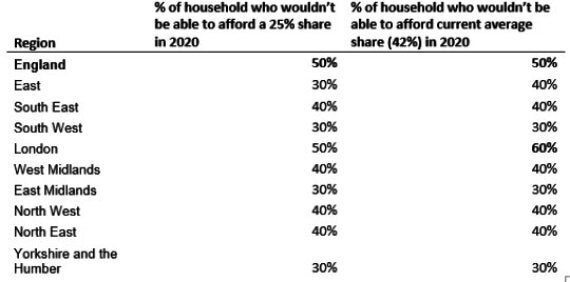The pre-announced bits of today's Comprehensive Spending Review have a welcome focus on house building, £4billion of which is devoted to building 135,000 new shared ownership homes during 2018-2020. As we've said many times before, we desperately need more affordable homes built, and shared ownership can play a useful part in the mix - but we're worried that funding for these homes may come at the expense of new low-rent homes for those who need them most.
So as the Chancellor prepares to give his speech, we considered who these Shared Ownership homes could work for.
Our first look at data on actual household incomes suggests that while this form of low-cost home ownership should be affordable for higher income families, at least half of households under 40 in England wouldn't be able to afford to buy a shared ownership property in 2020.
This means that if we replace low-rent housing with shared ownership, instead of investing in both, we risk leaving large numbers of low-to-middle income young, working families trapped in unstable, expensive private renting. To be clear, investing in shared ownership is not a bad idea per se, but it must come along side other solutions that work for these households.
Surprising as it may seems, low-rent homes are actually a really good route into home ownership for those households - the lower rents help people save, and if it's a council home they will get access to Right to Buy.
To assess how affordable shared ownership is likely to be for real working families, we looked at data from the DWP on real households' net earned income. We use the commonly accepted criteria that housing is affordable if 35% or less of household income is spent on it.
Of course, shared ownership schemes vary, so we use average shared ownership sale prices, rent rates and average regional service charges. Although some schemes do allow some households to purchase chares as low as 25%, most purchases are at 50% or even 75% - so we've run the analysis for households purchasing the average share of 42% as well.

These results suggest that in most regions, shared ownership does the job it was designed for - it is a stepping stone for middle and higher earning households. This means it is functioning as a form of intermediate tenure, something we at Shelter have long supported.
These numbers also, however, raise the possibility that government plans to expand shared ownership at the expense of low-rent housing will mean a sizeable number of low-to-middle income families could be left behind. In cheaper region such as the East Midlands, about a third of households would not even be able to afford a 25% share in 2020. In London and when considering England as a whole, only the richest half of households could afford even this low share - and of course many of them are already homeowners.
Moreover, previous National Housing Federation figures suggest that the average share purchased is actually 42%. This share would be unaffordable to at least 60% of households in London, which supports London Assembly Housing Committee findings that shared ownership is likely to be unaffordable for low and middle income earners in the capital.
Right to Buy, the forced sell-off of council homes and the re-defining of Starter Homes as affordable will result in an estimated loss of 180,000 low rent homes by 2020. This means that households for whom shared ownership and Starter Homes are out of reach will have nowhere to go but the expensive and unstable private rented sector.
So whilst a renewed focus on investment in affordable housing is welcome, it must be money for a broad range of tenures that caters to all families that desperately need secure and affordable homes.
Sara Mahmoud is an economic analyst at Shelter
This blog first appeared on the Shelter website, and can be read here